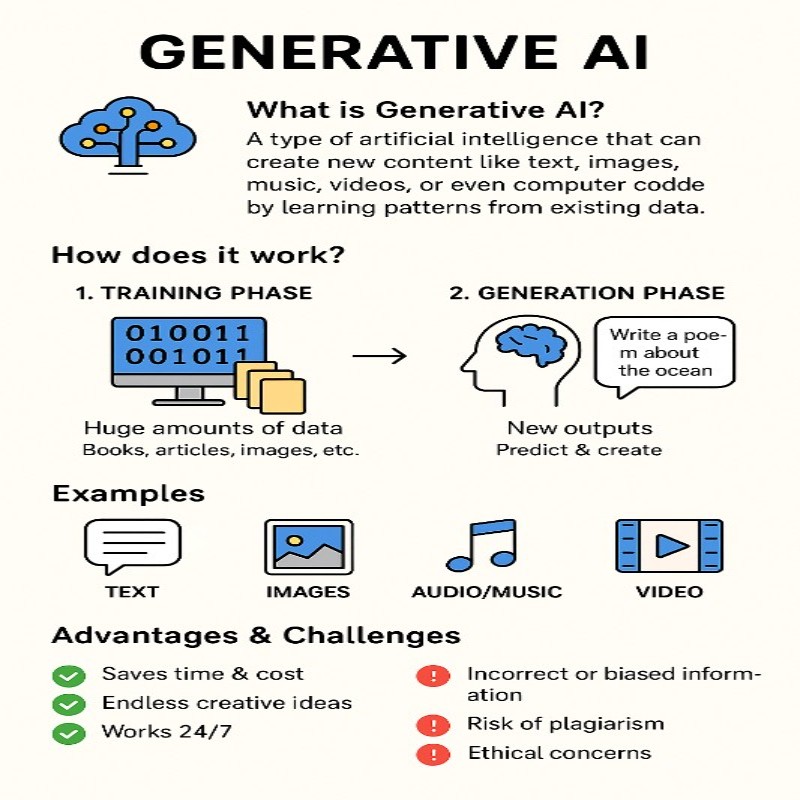What is Generative AI?
Generative AI is a branch of artificial
intelligence that can produce entirely new and original content—such as text,
images, audio, video, or even 3D designs—often so realistic that it is
difficult to distinguish from human-created work.
Unlike traditional AI, which mainly analyses data,
generative AI learns patterns from existing data and then generates new
data that resembles it.
Core Technology behind Generative AI
Generative AI relies on deep learning, a
specialized area of machine learning (ML) that uses neural networks with
multiple layers to model complex patterns. While machine learning is broad,
deep learning is particularly effective for generative tasks, such as creating
realistic images, producing human-like text, or composing music.
A central component of generative AI is the Large
Language Model (LLM). LLMs are self-supervised machine learning models
trained on massive amounts of text data using natural language processing
(NLP). They can understand, process, and generate human-like text. First large language model is GPT, stands for
Generative Pre-Trained Transformer.
Popular Generative AI Tools
- Chatbots: ChatGPT, Copilot, Gemini,
Claude, Grok, DeepSeek
- Text-to-Image
Models:
Stable Diffusion, Midjourney, DALL·E
- Text-to-Video
Models:
Veo, Sora
Leading Companies in Generative AI: OpenAI, Anthropic, xAI,
Microsoft, Google,
Applications of Generative AI
- Content
Creation
- Text:
Articles, stories, poems, or computer code
- Images:
Realistic artwork or edits from text prompts
- Audio:
Music, sound effects, or speech synthesis
- Video:
Short clips generated or edited from descriptions
- Code:
Auto-generating software programs based on user prompts
- Other
Uses: 3D
models, synthetic datasets for research, data augmentation
- Healthcare: Generating synthetic
medical images for study
- Education
& Research:
Creating additional datasets for AI training
Challenges of Generative AI
- Deepfakes: Fake videos and images
that can mislead viewers
- Bias: Reproduction of bias
present in training datasets
- Authenticity: Difficulty in
differentiating between real and generated content
- Ethical
Issues:
Ownership, copyright, and intellectual property concerns
- Job
Impact:
Potential large-scale replacement of human roles
- Cybersecurity
Risks:
Misuse for cybercrime
How Generative AI Works
- Trains
on large datasets (text, images, audio, video, etc.)
- Learns
underlying patterns, structures, and styles from the data
- Uses
this knowledge to generate new, consistent, and realistic outputs when
prompted
Historical Development of
Generative AI
- 1906 – Markov Chains by
Andrey Markov, used for probabilistic text generation
- 1970s – AARON by Harold
Cohen, a program that generated paintings
- 1980s–1990s – Generative AI Planning,
symbolic AI for action sequencing
- 2000s – Growth of Deep
Learning Models
- 2014 – Development of Variational
Autoencoders (VAE) and Generative Adversarial Networks (GAN)
- 2017 – Introduction of the Transformer
Network, enabling more advanced models
- 2018–2019 – Launch of GPT and GPT-2,
the first large-scale LLMs
VAE, GAN, and Transformers are considered the core
architectures of modern generative AI.
Key Milestones in Generative AI
Tools
- 2021 – OpenAI released DALL·E
for image generation
- 2022 – Midjourney
launched, specializing in text-to-image graphics
- Nov
2022 – ChatGPT
by OpenAI marked a turning point in AI adoption
- Mar
2023 –
Release of GPT-4 by OpenAI
- 2023 – Meta introduced ImageBind
(multi-modal AI); Google released Gemini (Ultra, Pro, Flash, Nano)
- Mar
2024 –
Anthropic launched Claude 3
- Jul
2025 –
OpenAI unveiled GPT-5
Author
Anjali Pawar (Developer)
